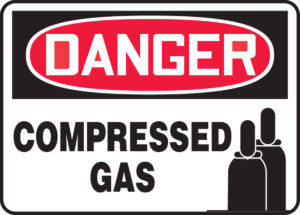Compressed gases & cylinder overview
The OSHA Hazard Communication Standard defines a compressed gas as:
- A gas or mixture of gases having, in a container, an absolute pressure exceeding 40 psi at 70 deg. F (21.1 deg. C); or
- A gas or mixture of gases having, in a container, an absolute pressure exceeding 104 psi at 130 deg. F (54.4 deg. C) regardless of the pressure at 70 deg. F (21.1 deg. C); or
- A liquid having a vapor pressure exceeding 40 psi at 100 deg. F (37.8 deg. C) as determined by ASTM D-323-72.
Compressed gases can be toxic, flammable, oxidizing, corrosive or inert. In the event of a leak, inert gases can quickly displace air in a large area creating an oxygen-deficient atmosphere, while toxic gases can create poison atmospheres, and flammable or reactive gases can result in fire and exploding cylinders. In addition, there are hazards from the pressure of the gas and the physical weight of the cylinder. A gas cylinder falling over can break containers and crush feet. The cylinder can itself become a missile if the cylinder valve is broken off.
general Regulatory information
Compressed gases are primarily regulated at the federal level by OSHA and require routine inspections, proper storage, handling and safety devices under OSHA 29 CFR 1910.101 Compressed Gases (General Requirements). There are additional requirements for specific compressed gases, such as acetylene, hydrogen, oxygen and nitrous oxide under OSHA 29 1910.102-105. In addition, the US DOT Hazardous Materials Regulations (HMR) regulate the safe and secure transportation of hazardous materials in commerce (49 CFR 171-177). At the state level, the Wisconsin Department of Safety and Professional Services (DSPS) regulates the use and storage of compressed gases under Wisconsin Administrative Code Chapter SPS 332, along with anhydrous ammonia, liquid natural gas, liquid petroleum gas, and liquid and gaseous hydrogen.
Cylinder Best Safety Practices
- Accept only properly identified cylinders and do not rely on color codes.
- Wear safety equipment appropriate for the hazard potential of the gas before beginning work.
- If a cylinder or valve is noticeably corroded, the vendor should be contacted for instructions.
- A leaking cylinder should be removed and isolated in a well-ventilated safe area. It may be necessary to call in trained emergency response personnel.
- If the leak is at the junction of the cylinder valve and cylinder, do not try to repair. Instead, contact the supplier.
- Leave cap on and valve closed when cylinder is not in use.
- When a cylinder is not connected to a system, the regulator should be removed and the cylinder should be capped.
- Store cylinders upright.
- Regulators should only be used for the gas for which they were designed and should not be interchanged. Do not force regulator connection fittings.
- Never drag, slide or roll the cylinder; never transport with the regulator in place; and secure the cylinder to a suitable hand truck or cart during transport.
- Properly secure cylinders in a well ventilated and protected area away from heat, flames and the sun.
- Segregated cylinders by hazard classes while in storage.
- Discontinue use of the cylinder when it has at least 25 psi remaining; close valve to prevent air and moisture from entering; return unused and empty cylinders to the vendor for reuse or refill.
- Mark or tag empty cylinders “EMPTY” or “MT.” Separate empty and full cylinders during storage.
- Do not purchase more or larger cylinders than necessary.
- Do not store flammable gases next to an exit or near oxygen cylinders.
- Do not use copper fittings or tubing on acetylene tanks.
- Do not use Teflon® tape on cylinder or tube fitting connections, which have metal-to-metal face seals or gasket seals.
- Do not allow oil or grease to contact cylinders or their valves, especially cylinders containing oxidizing gases.
additional Resources
- OSHA Compressed Gases (General Requirements)
- OSHA Compressed Gases and Equipment Information
- OSHA Laboratory Safety: Cryogens and Dry Ice
- Wisconsin DSPS Gas Systems Program
- US DOT Hazardous Materials Regulations (49 CFR 171-177)
- US DOT Free Publications: UN Cylinders: What you Need to Know
- CCOHS: Cryogenic Liquids Safety
- Compressed Gas Cylinder Association
Disclaimer
This publication was prepared for Environmental Health and Safety staff at University of Wisconsin System campuses, to assist in finding resources and information for regulatory compliance. It is not intended to render legal advice.
